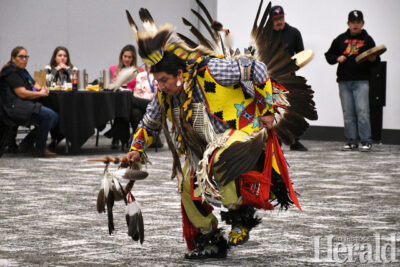Indigenous Tourism Alberta growing with local support
By Lethbridge Herald on December 6, 2023.
 Chicken dancer, Roger Hunt Jr. performs as part of the Indigenous Tourism Alberta mini-gathering on Wednesday at the Agri-Food Hub & Trade Centre.
Herald photo by Theodora MacLeod
Chicken dancer, Roger Hunt Jr. performs as part of the Indigenous Tourism Alberta mini-gathering on Wednesday at the Agri-Food Hub & Trade Centre.
Herald photo by Theodora MacLeodTheodora MacLeod – LETHBRIDGE HERALD – Local Journalism Initiative Reporter
When it comes to the tourism game, Indigenous Tourism Alberta (ITA), is still in its rookie stages, but if Wednesday’s gathering at the Agri-Food Hub & Trade Centre proved anything, it is that Indigenous tourism is on its way to being the next big thing, and ITA, in partnership with Tourism Lethbridge, is ready to help pave the way.
“Interest in Indigenous tourism has never been higher both domestically and internationally,” says ITA board member, Dion Red Gun in his opening remarks to an audience of more than 100 attendees, some already established as part of the Indigenous tourism landscape, with others interested in joining the industry, as well as representatives from throughout the region.
“ITA has helped pull the industry together with a unified voice which has helped with Indigenous tourism… there are strong Indigenous partnerships in place, particularly with Travel Alberta, ITAC (Indigenous Tourism Association of Canada), but also with the airlines, DMOs (destination management organizations) and partners across the province. This growth is helping Indigenous communities,” Red Gun explained.
According to one of the keynote speakers, University of Lethbridge professor emeritus Leroy Little Bear, what Indigenous tourism has that the typical legacy destinations in the province – such as Banff or Jasper – don’t have is a deep connection to the land and a cultural emphasis on relationships. Both key aspects in specifically Blackfoot culture.
CEO of ITA, Shae Bird says their organization hit the travel scene in 2019, just in time for a global lockdown that halted travel and threatened to destroy tourism.
“Indigenous tourism is a young industry from a commercial perspective,” he says, “These things have always happened, but no one supported them, no one marketed them. There was no Indigenous tourism before there was an Indigenous led organization, not that it wasn’t there but there was no voice for those members.”
Bird emphasized the importance of Indigenous-led organizations like ITA, adding that Travel Alberta was instrumental is helping to build the foundation.
Bird explained that throughout the province there are pockets of regions already showcasing Indigenous experiences and amenities.
He explained that all the regions in Alberta have the opportunity to grow their tourism industry, but he’s not naïve to the challenges.
“First and foremost, would be the accessibility, especially in more remote regions.”
With parts of the province currently lacking certain key infrastructure elements such as easy and accessible transportation, it creates an increased challenge for Indigenous tourism that many traditional branches of tourism might not face, he said.
With that, Bird said ITA’s focus right now is supporting businesses to get the export-ready stages where they can confidently welcome international guests and grow their connections with international travel organizations. With three new development programs for members to learn from; Strengthening Our Roots, Six Senses, and Pathways 2.0, it’s only a matter of time, he said.
CEO of Tourism Lethbridge, Erin Crane, announced continued support for Indigenous tourism.
“We will be covering the registration cost to Indigenous Tourism Alberta for any of the tourism businesses who are interested in learning and growing from their amazing programs,” she declared.
“We are really excited to make this happen and look forward to showcasing to the rest of the world how amazing southern Alberta is, from Medicine Hat to Crowsnest Pass.”
Following in her footsteps, Tourism Medicine Hat and South Canadian Rockies Tourism Association also announced they will be covering registration costs for businesses in their areas to participate in ITA’s development programs.
“We want to support educating our visitors about Indigenous culture and language, alongside visitor education, we want to support Indigenous operators in their endeavours through promotion and collaboration whenever possible,” says Brandy Fehr of South Canadian Rockies Tourism Association.
Following performances by local Indigenous dancers, including Chicken Dancers – a style of Indigenous dance said to have originated in southern Alberta – panel discussions on Artisan Tourism Development and Food Sovereignty and Agri-tourism were held featuring some of southern Alberta’s leaders Indigenous tourism such as William Singer III, owner of Naapi’s Garden and Katoyiss Seed Bank, Harley Bastien, owner of Buffalo Rock Tipi Camp, and Camina Weasel Moccasin, Indigenous Curator at the Galt Museum.
Wednesday’s ‘Mini-Gathering’ was the first of five that to be hosted by Indigenous Tourism Alberta throughout the province.
21-20



